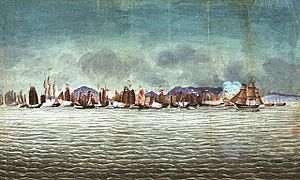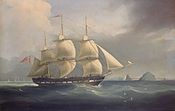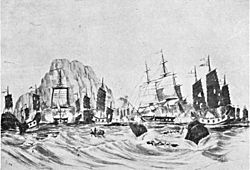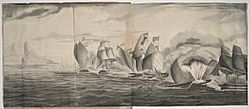Battle of Chuenpi facts for kids
Quick facts for kids First Battle of Chuenpi |
|||||||
|---|---|---|---|---|---|---|---|
| Part of the First Opium War | |||||||
 The Volage and Hyacinth engaging Chinese war junks |
|||||||
|
|||||||
| Belligerents | |||||||
| Commanders and leaders | |||||||
| Charles Elliot Henry Smith |
Lin Zexu Guan Tianpei |
||||||
| Strength | |||||||
| 1 frigate 1 sloop |
16 junks 13 fire rafts |
||||||
| Casualties and losses | |||||||
| 1 wounded 1 Frigate lightly damaged 1 Sloop lightly damaged |
15 killed 1 fire raft sunk 1 junk blown up 3 junks sunk several other junks damaged |
||||||
The First Battle of Chuenpi was a naval battle fought between British and Chinese ships. It took place on November 3, 1839. The fight happened at the entrance of the Humen strait in Guangdong province, China. This battle was an important event during the First Opium War. It started when two British ships, HMS Hyacinth and HMS Volage, fired at Chinese ships. The British saw these Chinese ships as a threat.
Why the Battle Happened
To trade in Canton (now Guangzhou), foreign ships had to sign a special agreement. This agreement stated they would not trade opium. Captain Charles Elliot was the main British trade official in China. He told British ships not to sign this agreement. If opium was found, the ship's goods would be taken, and the people involved could be executed. This rule made it hard for British traders to do business in China.
In October 1839, a ship called the Thomas Coutts arrived in Canton. Its captain, Warner, was not trading opium. He decided to sign the Chinese agreement, even though Captain Elliot had forbidden it. Warner believed Elliot's ban was not legal under British law.
Before Captain Warner left China, a Chinese official named Lin Zexu gave him a letter. This letter was for Queen Victoria. In it, Lin Zexu asked for the opium trade to stop. When Warner got to London, he gave the letter to one of the ship's owners. The owner tried to give it to the British Foreign Secretary, Lord Palmerston, but Palmerston's office refused to see him. So, Warner sent the letter to The Times newspaper, which then published it.
Captain Elliot saw Warner's actions as a challenge to his authority. To stop other British ships from going to Canton, Elliot ordered two British warships, HMS Hyacinth and HMS Volage, to block the way. They were placed about 1 mile south of the Chuenpi battery on October 27.
The Battle Begins
On November 3, 1839, another British ship, the Royal Saxon, tried to pass Elliot's blockade. The Volage, led by Captain Henry Smith, fired a warning shot. This shot went across the Royal Saxon's front. In response, Chinese war junks (traditional Chinese sailing ships) came out to protect the Royal Saxon. These junks were led by Admiral Guan Tianpei.
Captain Elliot eventually agreed to Captain Smith's request to attack. The British ships were faster and could move better. They sailed close to the Chinese vessels and fired all their side guns (called broadsides) at them.
Captain Smith later wrote that he felt it was important to fight. He believed it would protect the British flag and the merchant ships. A Chinese account by Wei Yuan said that Chinese warships went out to keep order. The English ships, however, thought the Chinese red flags meant war and started firing. In Europe, a red flag often meant war.
During the battle, one Chinese fire raft sank right away. A Chinese war junk exploded after its gunpowder storage (called a magazine) was hit. After their first attack, the Volage and Hyacinth turned around. They repeated the same move, firing their guns from the other side of the ship. The Chinese ships had fixed guns that could not be aimed easily.
One junk was blown up, three were sunk, and several others were damaged. The Chinese fleet could not match the British firepower and sailed away. Only Admiral Kuan's main ship, which had 12 cannons, kept fighting. Since it was not a big threat, Elliot told Smith to stop firing. This allowed the damaged Chinese flagship to escape. The Volage had minor damage to its sails and ropes (called rigging). The Hyacinth's back mast (called a mizzen-mast) was hit by a 12-pound cannonball. One British sailor was hurt, and 15 Chinese sailors were killed.
What Happened Next
After the battle, the Royal Saxon continued its journey to Canton. Captain Elliot returned to Macau. Historian Bruce A. Elleman explained that this battle was not just between the British and Chinese. It was also about the British Navy trying to stop one of Elliot's own ships. This ship had refused to follow his rules about free trade. The "Battle of Chuanbi" showed how much tension there was over trade during the Opium War.




